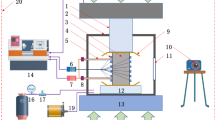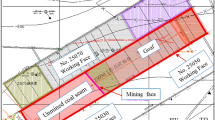Abstract
During the mining activities, coal–rock dynamic disasters have caused grievous casualties and massive property losses. It is the severe problem for regional monitoring of abnormal stress. Electrical potential (EP) can be produced on coal rock under loading, and its response is related closely with the loading stress and damage evolution. Meanwhile, electric field inversion has the advantage to realize regionalization monitoring in the space. To identify the abnormal stress localization characteristics in mining coal seam, after theoretical derivation, the strategy of EP inversion imaging on is studied under bilateral model. Further, simulation experiment of coal rock under loading is conducted. The abnormal probability zones of sample can be identified with EP inversion imaging, while it corresponds with severe damage zones with significant crack propagation. It can be utilized to reveal the localized characteristics of damage and failure of coal rock spatially. Finally, the results of EP inversion in the mining coal seam indicate that the abnormal probability zones can be considered as stress concentration and dynamic hazard areas. Its effectiveness is verified by microseismic monitoring and rock-burst hazard assessment. The study provides a new idea to monitor abnormal stress zone regionally and forecast dynamic disasters in the field.



















Similar content being viewed by others
References
Aldridge DF, Oldenburg DW (2010) Direct current electric potential field associated with two spherical conductors in a whole-space1. Geophys Prospect 37:311–330
Aydin A, Dobbs MR, Reeves HJ, Kirkham MP, Graham CC (2013) Stress induced electric field measurements of different rock lithology using the Electric Potential Sensor
Benisch K, Köhn D, Hagrey SA, Rabbel W, Bauer S (2015) A combined seismic and geoelectrical monitoring approach for CO2 storage using a synthetic field site. Environ Earth Sci 73:3077–3094
Cao W, Shi J-Q, Si G, Durucan S, Korre A (2018) Numerical modelling of microseismicity associated with longwall coal mining. Int J Coal Geol 193:30–45
Cartwright-Taylor A, Vallianatos F, Sammonds P (2014) Superstatistical view of stress-induced electric current fluctuations in rocks. Physica A 414:368–377. https://doi.org/10.1016/j.physa.2014.07.064
Chong C, Ma L, Li Z, Ni W, Song S (2015) Logarithmic mean Divisia index (LMDI) decomposition of coal consumption in China based on the energy allocation diagram of coal flows. Energy 85:366–378
Colangelo G, Lapenna V, Perrone A, Piscitelli S, Telesca L (2006) 2D self-potential tomographies for studying groundwater flows in the Varco d’Izzo landslide (Basilicata, southern Italy). Eng Geol 88:274–286
Corwin RF, Hoover DB (1979) The self-potential method in geothermal exploration. Geophysics 44:226–245
Crespy A, Revil A, Linde N, Byrdina S, Jardani A, Bolève A, Henry P (2008) Detection and localization of hydromechanical disturbances in a sandbox using the self-potential method. J Geophys Res. https://doi.org/10.1029/2007jb005042
Darnet M, Marquis G, Sailhac P (2006) Hydraulic stimulation of geothermal reservoirs: fluid flow, electric potential and microseismicity relationships. Geophys J Int 166:438–444
Düzgün H (2005) Analysis of roof fall hazards and risk assessment for Zonguldak coal basin underground mines. Int J Coal Geol 64:104–115
Düzgün HS, Leveson N (2018) Analysis of soma mine disaster using causal analysis based on systems theory (CAST). Saf Sci 110:37–57
Fan C, Li S, Luo M, Du W, Yang Z (2017) Coal and gas outburst dynamic system. Int J Min Sci Technol 27:49–55
Guo ZQ, You J, Li G, Shi X (1989) The model of compressed atoms and electron emission of rock fracture. Chin J Geophys 32:173–177
Haas AK, Revil A, Karaoulis M, Frash L, Hampton J, Gutierrez M, Mooney M (2013) Electric potential source localization reveals a borehole leak during hydraulic fracturing. Geophysics 78:D93–D113. https://doi.org/10.1190/geo2012-0388.1
He M (2014) Research on the potential inversion imaging method based on seam stress abnormalities. Dissertation, China University of Mining and Technology
Hosseini N (2017) Evaluation of the rockburst potential in longwall coal mining using passive seismic velocity tomography and image subtraction technique. J Seismol 21:1101–1110
Iqbal N, Al-Shuhail AA, Kaka SI, Liu E, Raj AG, McClellan JH (2017) Iterative interferometry-based method for picking microseismic events. J Appl Geophys 140:52–61
Lawson HE, Tesarik D, Larson MK, Abraham H (2017) Effects of overburden characteristics on dynamic failure in underground coal mining. Int J Min Sci Technol 27:121–129
Le TD, Oh J, Hebblewhite B, Zhang C, Mitra R (2018) A discontinuum modelling approach for investigation of Longwall Top Coal Caving mechanisms. Int J Rock Mech Min Sci 106:84–95
Li Z (2007) Study on surface potential effect and its mechanism of coal during deformation and fracture under load. Dissertation, China University of Mining and Technology
Ma C, Li H, Niu Y (2018) Experimental study on damage failure mechanical characteristics and crack evolution of water-bearing surrounding rock. Environ Earth Sci 77:23
Marland S, Merchant A, Rowson N (2001) Dielectric properties of coal. Fuel 80:1839–1849
Nguyen S, Vu M-H, Vu M (2015) Extended analytical approach for electrical anisotropy of geomaterials. J Appl Geophys 123:211–217
Ogaya X, Ledo J, Queralt P, Jones AG, Marcuello Á (2016) A layer stripping approach for monitoring resistivity variations using surface magnetotelluric responses. J Appl Geophys 132:100–115
Patella D (1997) Introduction to ground surface self-potential tomography. Geophys Prospect 45:653–681
Porwal A, Carranza EJM (2015) Introduction to the special issue: GIS-based mineral potential modelling and geological data analyses for mineral exploration. Ore Geol Rev 71:477–483
Revil A, Mahardika H (2013) Coupled hydromechanical and electromagnetic disturbances in unsaturated porous materials. Water Resour Res 49:744
Revil A, Ehouarne L, Thyreault E (2001) Tomography of self-potential anomalies of electrochemical nature. Geophys Res Lett 28:4363–4366. https://doi.org/10.1029/2001gl013631
Revil A, Titov K, Doussan C, Lapenna V (2006) Applications of the self-potential method to hydrological problems. In: Applied hydrogeophysics. Springer, Berlin, pp 255–292
Revil A, Mao D, Shao Z, Sleevi MF, Wang D (2017) Induced polarization response of porous media with metallic particles—part 6: the case of metals and semimetals. Geophysics 82:E97–E110
Shao Z, Wang D, Wang Y, Zhong X, Tang X, Xi D (2015) Electrical resistivity of coal-bearing rocks under high temperature and the detection of coal fires using electrical resistance tomography. Geophys J Int 204:1316–1331
Shao Z, Revil A, Mao D, Wang D (2017) Induced polarization signature of coal seam fires. Geophys J Int 208:1313–1331
Soengkono S, Bromley C, Reeves R, Bennie S, Graham D (2013) Geophysical techniques for low enthalpy geothermal exploration in New Zealand. Explor Geophys 44:215–227
Song X, Li X, Li Z, Zhang Z, Cheng F, Chen P, Liu Y (2018) Study on the characteristics of coal rock electromagnetic radiation (EMR) and the main influencing factors. J Appl Geophys 148:216–225
Srivardhan V, Pal S, Vaish J, Kumar S, Bharti AK, Priyam P (2016) Particle swarm optimization inversion of self-potential data for depth estimation of coal fires over East Basuria colliery, Jharia coalfield, India. Environ Earth Sci 75:688
Stoll J, Bigalke J, Grabner EW (1995) Electrochemical modelling of self-potential anomalies. Surv Geophys 16:107–120
Szwedzicki T (2003) Rock mass behaviour prior to failure. Int J Rock Mech Min Sci 40:573–584
Triantis D, Anastasiadis C, Vallianatos F, Kyriazis P (2007) Electric signal emissions during repeated abrupt uniaxial compressional stress steps in amphibolite from KTB drilling. Nat Hazards Earth Syst Sci 7:149–154
Vozoff K, Smith G, Hatherly P, Thomson S (1993) An overview of the radio imaging method in Australian coal mining. First Break 11:13–21
Wang J, Wang Z, Yang S (2017) A coupled macro-and meso-mechanical model for heterogeneous coal. Int J Rock Mech Min Sci 94:64–81
Yoshida S, Clint OC, Sammonds PR (1998) Electric potential changes prior to shear fracture in dry and saturated rocks. Geophys Res Lett 25:1577–1580. https://doi.org/10.1029/98gl01222
Zhang C, Canbulat I, Hebblewhite B, Ward CR (2017) Assessing coal burst phenomena in mining and insights into directions for future research. Int J Coal Geol 179:28–44
Zhao Y, Jiao Z, Liu H, Jiang Y, Delong QI, Beijing T, Beijing T (2017) Simulation of ground pressure distribution at large mining height face based on GIS techniques. J China Univ Min Technol 46:33–40
Acknowledgements
This work is supported by the State Key Research Development Program of China (Grant No. 2016YFC0801404), General Program of National Natural Science Foundation of China (51674254), State Key Laboratory of Coal Resources and Safe Mining, CUMT (SKLCRSM15X03), A Project Funded by the Priority Academic Program Development of Jiangsu Higher Education Institutions (PAPD). We thank Dr. Lanbo Liu, from University of Connecticut, for editing the English text of a draft of this manuscript.
Author information
Authors and Affiliations
Corresponding authors
Additional information
Publisher’s Note
Springer Nature remains neutral with regard to jurisdictional claims in published maps and institutional affiliations.
Rights and permissions
About this article
Cite this article
Li, Z., Niu, Y., Wang, E. et al. Study on electrical potential inversion imaging of abnormal stress in mining coal seam. Environ Earth Sci 78, 255 (2019). https://doi.org/10.1007/s12665-019-8246-8
Received:
Accepted:
Published:
DOI: https://doi.org/10.1007/s12665-019-8246-8




